SOC 2 Type 1 vs Type 2: Which Do You Actually Need?
Should you get SOC 2 Type 1 or Type 2? Discover how each audit type works, what enterprise customers require, and how to get compliant quickly.
- Home
- Compliance HubHub
- SOC 2 Type 1 vs Type 2: Which Do You Actually Need?
If you're handling customer data as a service provider, you've probably heard this a lot: SOC 2 compliance is basically table stakes now. Customers expect it, enterprise deals depend on it, and proving you have solid security controls matters more than ever.
But here's where things get confusing: Should you pursue SOC 2 Type 1 or SOC 2 Type 2?
Both reports are legitimate. Both prove security. But they serve very different purposes, and choosing the right one can save you time, money, and help you actually close those deals waiting on compliance.
This guide breaks down everything you need to know about SOC 2 Type 1 vs Type 2 so you can make the right call for your business.
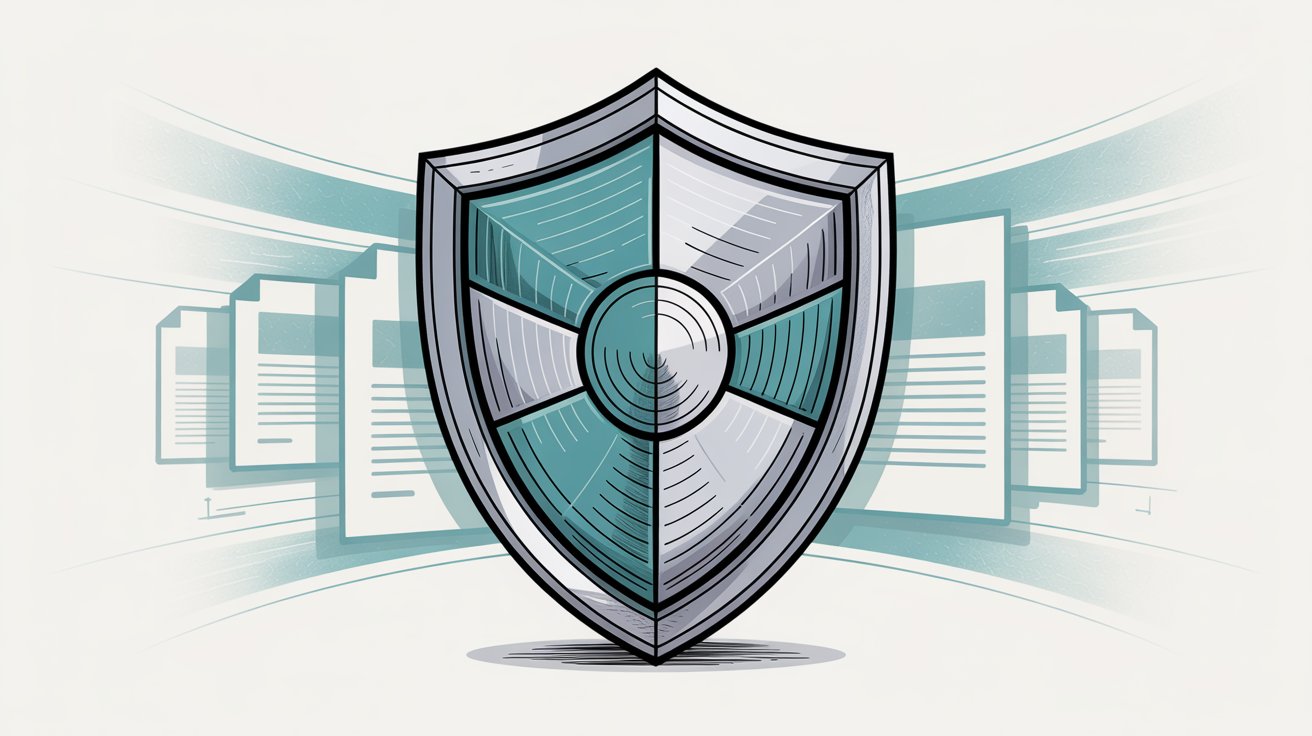
What is SOC 2 Compliance and Why Are There Two Different Report Types?
SOC 2 (Service Organization Control 2) is an auditing framework from the AICPA that evaluates how well you protect customer data. It's based on five Trust Services Criteria: security, availability, processing integrity, confidentiality, and privacy.
Unlike certifications with a simple pass/fail, a SOC 2 audit results in an attestation report from a CPA. Think of it as a detailed document that provides assurance about your internal controls.
SOC 2 reports come in two varieties:
- SOC 2 Type 1: An attestation of your control design at a single point in time (a snapshot)
- SOC 2 Type 2: An attestation of both the design and operating effectiveness of your controls over a period of time (typically 3 to 12 months)
Both require a formal audit by a qualified CPA firm, but the scope and depth differ significantly. Understanding those differences is key to deciding which report will satisfy your stakeholders.
SOC 2 Type 1 Explained: What Does a Point-in-Time Security Audit Cover?
A SOC 2 Type 1 report evaluates whether your security controls are properly designed as of a particular date. Think of it as a snapshot audit. The auditor examines your systems and policies at that specific moment to determine if you've put appropriate controls in place to meet SOC 2 criteria.
Importantly, a Type 1 does not test how well those controls operate over time. It only verifies that they exist and are set up correctly on the audit date.
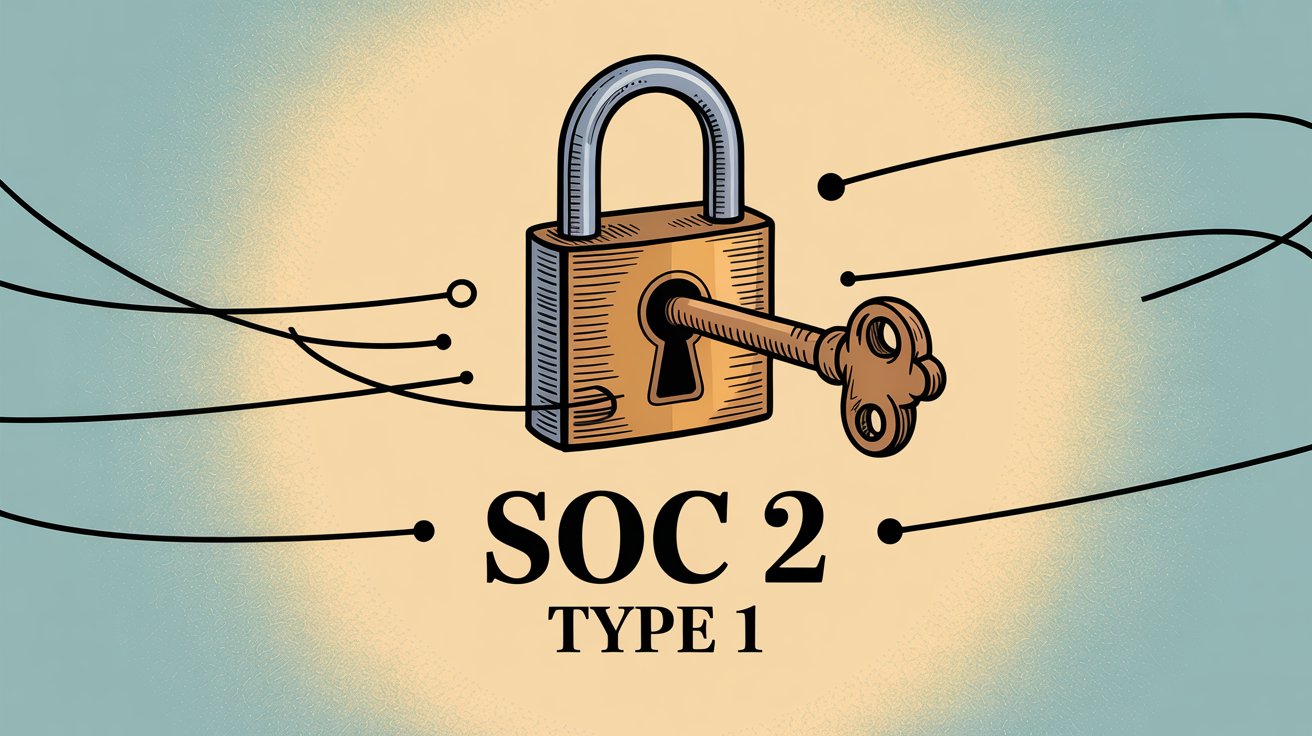
Key Characteristics of SOC 2 Type 1
Timing: Covers a single point in time (the audit date)
For example, an auditor might examine your controls as of December 1, 2025, and issue the report for that specific date.
Focus: Evaluates the design and implementation of controls
The question answered is: "Are your controls suitably designed to meet the Trust Services Criteria right now?"
Effort & Duration: Faster and less resource-intensive than Type 2
A Type 1 audit can typically be completed in weeks once controls are in place. Many organizations can prepare and undergo a Type 1 in 1 to 3 months total (though modern compliance automation platforms can compress this to days).
Cost: Generally less expensive than Type 2
Fewer audit hours are needed since it's one point in time. According to industry data, a Type 1 audit might cost in the range of $5K to $25K, depending on scope, whereas Type 2 audits cost 30% to 50% more on average. Use Comp AI's SOC 2 cost estimator to get a personalized budget estimate.
Output: The report includes a description of your system, management's assertion, and the auditor's opinion
If all goes well, the auditor opines that your controls are suitably designed as of that date. The report essentially states: "Your controls were suitably designed to meet the criteria as of 12/1/2025."
When Should You Get SOC 2 Type 1? (Best Use Cases)
SOC 2 Type 1 is often considered a "starting point" for compliance. It's particularly useful if you are:
→ New to SOC 2 or early-stage as a company
Type 1 lets you demonstrate you have the right security policies and controls on paper and in practice without waiting months. It's a common first step for startups building a security program. Check out Comp AI's SOC 2 checklist for SaaS startups to get started.
→ Under a tight timeline to show compliance
If a big prospect or partner is asking now for a SOC 2 report to close a deal, a Type 1 can be obtained much faster than a Type 2. It provides initial proof of security to satisfy due diligence in the short term. Comp AI's SOC 2 timeline calculator can help you plan your certification path.
→ Making major changes or just implemented controls
If your systems or processes were recently overhauled, you might not have 6 to 12 months of history to show. A Type 1 can attest that, as of today, your new controls are in place and meet the standard.
→ Building confidence internally
Going through a Type 1 helps your team prepare for the rigor of a Type 2. It's like a trial run that can uncover design gaps to fix before you're tested on operating effectiveness. Start with a SOC 2 readiness assessment to identify potential gaps.
Think of it this way: A SOC 2 Type 1 is about showing you have the right security blueprint. It looks good on paper and meets the specs. It doesn't yet prove the house is built solidly, but it reassures everyone that the design is sound.
SOC 2 Type 2 Explained: How Does Ongoing Effectiveness Testing Work?
A SOC 2 Type 2 report goes a big step further. It evaluates not only your control designs but also whether they're operating effectively over time. In other words, the auditor will test evidence that your security controls actually work consistently during a review period.
This period is typically anywhere from 3 to 12 months long.
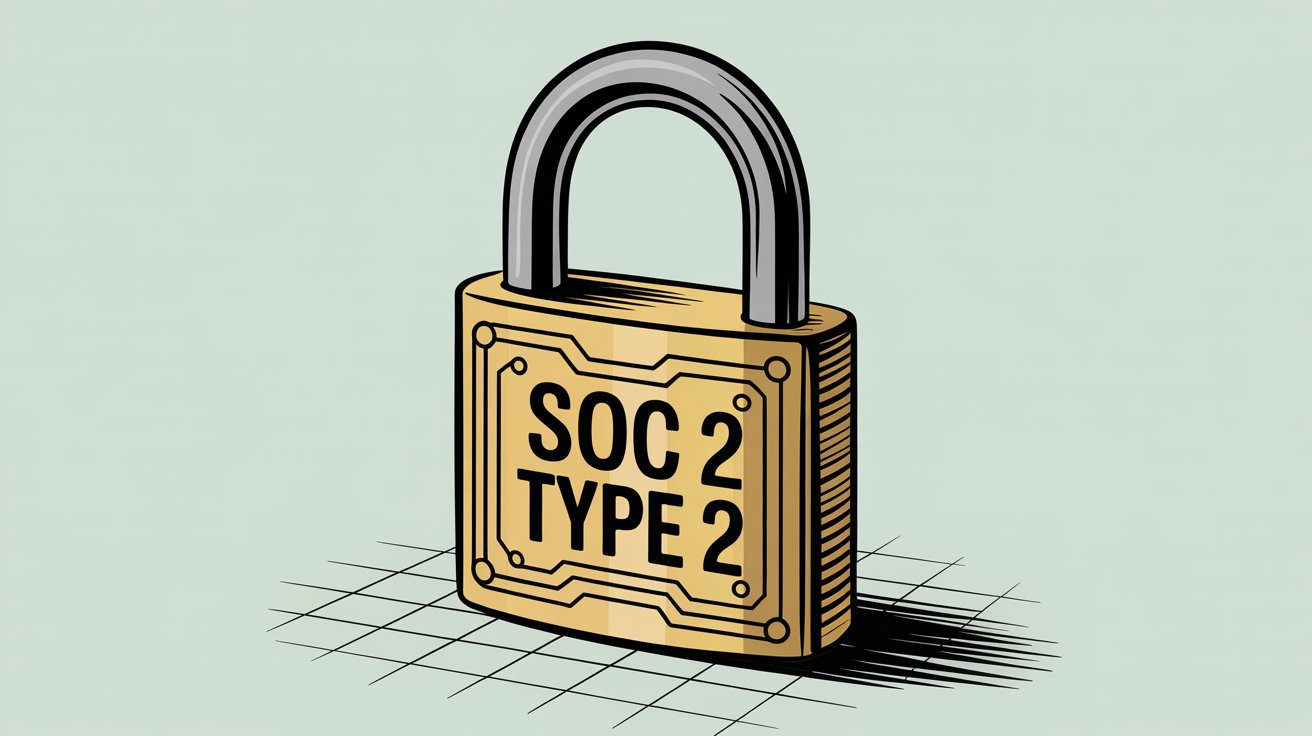
Key Characteristics of SOC 2 Type 2
Timing: Covers a span of time, usually 3, 6, or 12 months
The minimum observation period is often 3 months for a first Type 2 audit. Many companies choose a 6- or 12-month window for subsequent audits.
Focus: Evaluates operational effectiveness of controls throughout that period
It answers: "Are your controls not only well-designed, but also functioning as intended day-to-day?" The auditor will sample evidence across the months (log files, change management records, incident tickets) to see that you followed your policies consistently.
Effort & Duration: Much more intensive than Type 1
You must maintain vigilance and collect evidence continuously during the period. The audit itself also takes longer since auditors examine many data points. A Type 2 audit (including its observation period) commonly takes 6 to 12 months to complete with traditional methods. However, automated compliance software can dramatically reduce this timeline.
Cost: Higher cost than Type 1 due to the extended scope
Not only are auditor fees higher (one estimate: around 30% to 50% more than Type 1), but you also invest more internal resources to sustain controls over the period. Still, many firms consider it a worthwhile investment since Type 2 is the "gold standard" of SOC 2.
Output: The Type 2 report contains everything a Type 1 does plus details on the tests performed
If successful, the auditor states that your controls were suitably designed and operated effectively from Date A to Date B.
Why Do Enterprise Customers Require Type 2?
Because SOC 2 Type 2 is the report that carries the most weight with customers, partners, and regulators. It demonstrates sustained, real-world security discipline.
CONTINUING THE ANALOGYIf a Type 1 is the blueprint, a Type 2 is like inviting an inspector to observe the house over months of use. It verifies that the foundation is solid, the alarms actually work, and the doors stay locked day and night. It proves you don't just have security controls in theory, but in practice on your best day and your worst days.
When is SOC 2 Type 2 Required? (Critical Use Cases)
SOC 2 Type 2 is often considered the "gold standard" report, and eventually most companies handling sensitive data will need it. Scenarios where Type 2 is especially important:
→ Enterprise and mid-market customers
Larger clients (and their procurement/security teams) almost always prefer a Type 2 report. Many enterprise deals hinge on providing a recent SOC 2 Type 2 as proof of mature operations. It's not uncommon for potential customers to reject a Type 1 report or view it as insufficient.
→ Competitive advantage
In a crowded SaaS market, having a Type 2 can set you apart. It signals your organization has reached a higher level of security maturity and can be trusted with high-stakes data.
→ Regulatory or investor expectations
While SOC 2 itself isn't legally mandated, certain regulators or due diligence processes effectively expect a Type 2 for critical service providers. If you work with financial institutions, healthcare providers, or other regulated entities, a Type 2 report provides stronger assurance of ongoing compliance.
→ Long-term growth
If your strategy is to move upmarket or handle more sensitive workloads, you'll eventually need a Type 2. Many startups start with Type 1 but plan for Type 2 as they scale. A Type 2 report demonstrates your security program is not one-and-done but an ongoing, monitored practice.

It's worth noting that once you achieve a Type 2, you'll need to renew it on a regular cadence (usually annually) to keep the trust intact. Customers will want to see a report from the past 12 months. This means maintaining continuous compliance and scheduling a follow-up Type 2 each year.
SOC 2 Type 1 vs Type 2: Complete Comparison Chart
Let's recap the side-by-side key differences:
Aspect | Type 1 | Type 2 |
|---|---|---|
Time Frame | One point in time (snapshot) | Period of time (3-12 months) |
What's Assessed | Control design only | Design + operational effectiveness |
Duration & Effort | Weeks to complete | 3-12 months observation period |
Cost | $5K-$25K typically | 30-50% more than Type 1 |
Assurance Level | Basic (controls exist and are designed well) | High (controls work consistently over time) |
Best Use Case | Quick validation, early-stage compliance | Sustained trust, enterprise deals |
Customer Perception | Opens doors, shows seriousness | Seals deals, inspires confidence |
Time Frame of Evaluation: Type 1 examines controls at one point in time (as of today), whereas Type 2 examines controls over a period of time (over the last 6 months, for example). Type 1 is a snapshot. Type 2 is a movie reel.
What's Being Assessed: Type 1 asks: "Are your controls designed appropriately?" It checks the existence and design of policies and procedures. Type 2 asks: "Are your controls working effectively day-to-day?" It tests that those controls actually operate consistently.
Level of Assurance: A Type 1 provides a basic level of assurance. It tells stakeholders "we have the right controls in place." A Type 2 provides a high level of assurance: "we not only have the right controls, we consistently use them effectively." As a result, a Type 2 is viewed as more robust and trustworthy, especially by risk-conscious customers.
Customer Perception: A Type 1 report can open doors by showing you take security seriously (often enough for initial conversations or smaller deals). A Type 2 report, however, can seal the deal. Many large clients will insist on a current Type 2 before signing, as it indicates a mature and reliable security program.
In other words, Type 1 might check a box, but Type 2 inspires deeper confidence.
Both types have their place. In fact, they aren't mutually exclusive. Many organizations will do a Type 1 first and follow it with a Type 2. The key is understanding what your situation calls for.
How to Decide: SOC 2 Type 1 or Type 2 for Your Business?
So, how do you decide between pursuing a Type 1 vs Type 2? The decision usually boils down to a few factors about your business needs, timeline, and stakeholders. Let's break down the considerations:
What Do Your Customers Actually Require?
What are the people asking for this report actually expecting? If a prospective enterprise client explicitly requires a SOC 2 Type 2, then that's your answer. You'll need a Type 2 to satisfy them.
Often, clients might simply say "SOC 2" without specifying type. In those cases, consider the norm in your market. Type 2 is increasingly the expected standard for due diligence. If you're unsure, ask your prospect if a Type 1 would suffice initially.
Some might accept a Type 1 as an interim with a plan to get Type 2 later, especially if you're a smaller vendor. But be aware that enterprise security teams prefer Type 2 and may reject a Type 1 report as incomplete.
If you're repeatedly hearing requests for "latest SOC 2 report" from bigger deals, lean toward Type 2.
How Fast Do You Need Compliance? (Timeline Pressure)
How urgently do you need a SOC 2 report? Timeline is often the deciding factor.
If you have an important customer or investor saying "we need proof of SOC 2 ASAP (in weeks, not months)," a Type 1 is the practical choice to meet that deadline. A Type 1 can be completed much faster, giving you a report perhaps in a couple of months or even weeks with the right preparation.
On the other hand, if you don't have any imminent deadlines and can afford a longer runway, going for Type 2 directly might be worthwhile. Some organizations intentionally schedule a Type 2 audit early and inform prospects, "Our SOC 2 Type 2 is underway and will be ready by Q2," as many will wait for the more robust report.
Bottom line: Choose Type 1 for immediate short-term needs. Choose Type 2 if you have the luxury of time and want the stronger report from the get-go.
What's Your Budget and Available Resources?
While you should never prioritize cost over security, the reality is Type 2 will cost more and consume more internal resources. Smaller companies with limited budgets may opt for a Type 1 first because it's cheaper to attain upfront.
Auditor fees for Type 2 are higher, and your team will spend several extra months on evidence gathering and meetings. That said, consider the broader context: if a Type 2 could help land a $500k contract, the ROI justifies itself.
Also, note that some audit firms offer package deals. For example, if you commit to doing a Type 1 and Type 2 with them in succession, they might charge a combined rate that smooths out the costs.
If budget is extremely tight and you can only do one audit this year, a Type 1 is easier on the wallet. Just plan to invest in a Type 2 when resources allow, because it likely awaits you down the road.
How Mature Are Your Security Controls?
Assess how mature your internal controls and processes are right now. If you just set up all your information security policies and security tools last month, diving straight into a Type 2 might be risky. You could fail the effectiveness tests if things haven't been running long.
In such cases, doing a Type 1 first makes sense: it validates your control design and gives your team time to operate those controls consistently for a few months before the Type 2.
On the other hand, if your company has had formal security practices for a while (say, you've enforced access controls, incident response, training for a year or more), you might be ready to skip to Type 2. A good rule of thumb: if you're confident you could pass 3 to 6 months of scrutiny on control effectiveness today, Type 2 is within reach.
Some auditors explicitly recommend first-timers start with Type 1 as a "baseline" and then roll into an annual Type 2 cycle. It helps iron out any design issues and eases your organization into the ongoing compliance discipline.
What's Your Growth Strategy and Competitive Position?
Think about how this compliance effort fits into your business strategy. Are you trying to quickly unlock a few deals to get revenue in the door? Type 1 will check the box for now and is ideal for early-stage growth when speed matters more than perfection.
If you're positioning your company as an enterprise-grade, security-first leader in your space, a Type 2 report signals that high bar and could be a competitive differentiator.
Also, consider what your competitors have. If all the other vendors a client is evaluating have Type 2 reports, presenting only a Type 1 might put you at a disadvantage. On the flip side, if Type 2 is rare in your niche, obtaining it could give you an edge.
How Sensitive Is the Data You Handle?
The more sensitive the data or services you provide, the more your customers will demand rigorous proof. For instance, a SaaS handling financial transaction data or health information will face greater scrutiny than one handling low-risk data.
If you're in a high-risk category, aim for a Type 2 sooner than later because it demonstrates consistent risk management over time. If you're handling moderate data and just need to demonstrate basic due diligence, a Type 1 might suffice initially to show you're on the right track. Review Comp AI's SOC 2 compliance requirements to understand what's needed for your industry.
Should You Do One Audit or Two?
Consider the efficiency of doing one versus two audits in succession. A Type 1 is not mandatory before Type 2. You can go straight to Type 2 if you choose. Doing so means you undergo one audit process (albeit longer), get the Type 2, and you're done (apart from annual renewals).
If you do a Type 1 now, you will still need to do a Type 2 later, effectively meaning two audits and two auditor fees. Some compliance advisors argue that if you can handle it, skipping directly to Type 2 saves time and money overall by avoiding the duplicate effort.
Others argue that without a Type 1, you might stumble in the Type 2 (which could then require a remedial Type 1 anyway), so the safer route is two-stage. Evaluate your team's confidence: if you're well-prepared and time isn't pressing, one thorough Type 2 audit may be more efficient than two separate audits.
But if you have any doubts or need that quick win, doing Type 1 first can de-risk the process. It's not uncommon for startups to do Type 1, celebrate the achievement (it can help marketing and sales in the short term), then immediately start the Type 2 process armed with the lessons from Type 1.
Real-World Scenarios: Which Report Should You Choose?
SCENARIO: Fortune 500 Prospect
Situation: "We have a Fortune 500 prospect asking for a SOC 2 report before they sign the deal next month."
Recommendation: → Go for Type 1
Rationale: You won't complete a Type 2 in time. Communicate to the prospect that a Type 2 is on your roadmap, but the Type 1 demonstrates your current controls. In parallel, plan out your Type 2 timeline.
SCENARIO: Enterprise Planning
Situation: "We're planning to sell to enterprise clients in 6 to 12 months, but no one's demanding a report today."
Recommendation: → Consider aiming for Type 2 directly
Rationale: Use the lead time to set up controls and gather evidence for a 3+ month period. By the time those big prospects are in discussion, you'll have a Type 2 ready, which will smooth the sales process.
SCENARIO: Seed-Stage Startup
Situation: "Our startup is seed-stage. We want to build trust early, but we're only 10 people and new to compliance."
Recommendation: → Type 1 is a great way to get on the board
Rationale: It's faster and less heavy lift for a small team. You prove your security design now, start attracting customers, and then tackle Type 2 when you have a bit more maturity.
SCENARIO: Type 1 Already Complete
Situation: "We already did a Type 1 six months ago. Now a customer is asking for a current SOC 2."
Recommendation: → It might be time to proceed to Type 2
Rationale: Many companies use the momentum from a Type 1 to immediately roll into the Type 2 audit. Use the work you've done, and use your Type 1 report to show clients you are in the process of getting a Type 2.
How to Get Compliant Faster: Automation Tools and Best Practices
Whether you choose Type 1, Type 2, or both, one thing is certain: you'll want to streamline the compliance process as much as possible. Traditional SOC 2 preparation can take months of manual effort (drafting policies, collecting screenshots, evidencing controls), but modern solutions are changing the game.
Here are some tips and considerations to help you get compliant faster and more efficiently:
How Automation Speeds Up Both Type 1 and Type 2
Compliance automation software can drastically cut down the work and time needed for both Type 1 and Type 2. For example, automated evidence collection can continuously gather proof that your controls are in place (user access lists, configuration screenshots), saving you from scrambling during the audit.
Automation is especially valuable for Type 2, where evidence is needed over many months. Tools can monitor your systems 24/7 and alert you to issues before an auditor finds them.
For instance, companies using platforms like Comp AI have gotten Type 1 audit-ready in as little as 24 hours (versus the typical 3 months) and Type 2 audit-ready in around 14 days of prep (versus the typical 6+ months). In short, automation can compress your timeline significantly while reducing human error.
SOC 2 Readiness Assessment: Know Before You Go
Before diving into any audit, do an internal readiness check. Many platforms and consultants offer SOC 2 readiness assessments that identify gaps in your controls or documentation. This is highly recommended whether you aim for Type 1 or Type 2.
A readiness assessment will tell you if you're actually prepared for a Type 2 (or if you should do a Type 1 first). It's like a dress rehearsal. Fix the weaknesses now so you can sail through the formal audit. You can also use Comp AI's SOC 2 compliance checklist to ensure you've covered all the bases.
Choosing the Right Auditor Makes a Difference
Auditor selection matters. An experienced SOC 2 auditor can provide valuable guidance during the process. While they must remain independent, good auditors will communicate issues they find so you can address them.
If you plan to do both Type 1 and Type 2, you might stick with the same audit firm for continuity. Some firms will offer a package deal or at least a smoother transition from your Type 1 to Type 2.
Also, using a firm familiar with modern compliance automation platforms can help. They may integrate directly with your tool, making evidence review faster.
Continuous Compliance: Don't Stop After Type 1
If you do a Type 1 now, treat it not as a one-off box to check, but as the launch of your ongoing compliance program. Start operating as if you're in a Type 2 observation period even if the Type 1 is done. That way logs, records, and habits are being collected and ingrained, which will make your eventual Type 2 much easier.
In other words, don't relax after Type 1. Use that momentum to enforce your controls daily. This could shorten the time you need to be ready for a Type 2.
Many companies find that the real heavy lift is getting initial controls in place (which Type 1 covers). After that, maintaining them for Type 2 is not too bad if you've automated alerts and have management buy-in. Consider implementing logging and monitoring policies and continuous monitoring tools to stay audit-ready year-round.
Keep Your Stakeholders Informed
If you choose a path (say, starting with Type 1), be transparent with those who asked for SOC 2. Let your customers or partners know: "We've completed a SOC 2 Type 1 this quarter, demonstrating our controls are in place. We are scheduled to undertake a SOC 2 Type 2 covering the next X months, to further validate operational effectiveness."
Most reasonable partners will appreciate the clarity. If someone really needs a Type 2 immediately and you only have a Type 1, see if you can provide alternate assurances (like sharing internal policies, or a bridge letter from your auditor) while the Type 2 is in progress.
Communication can often bridge the gap in expectations.
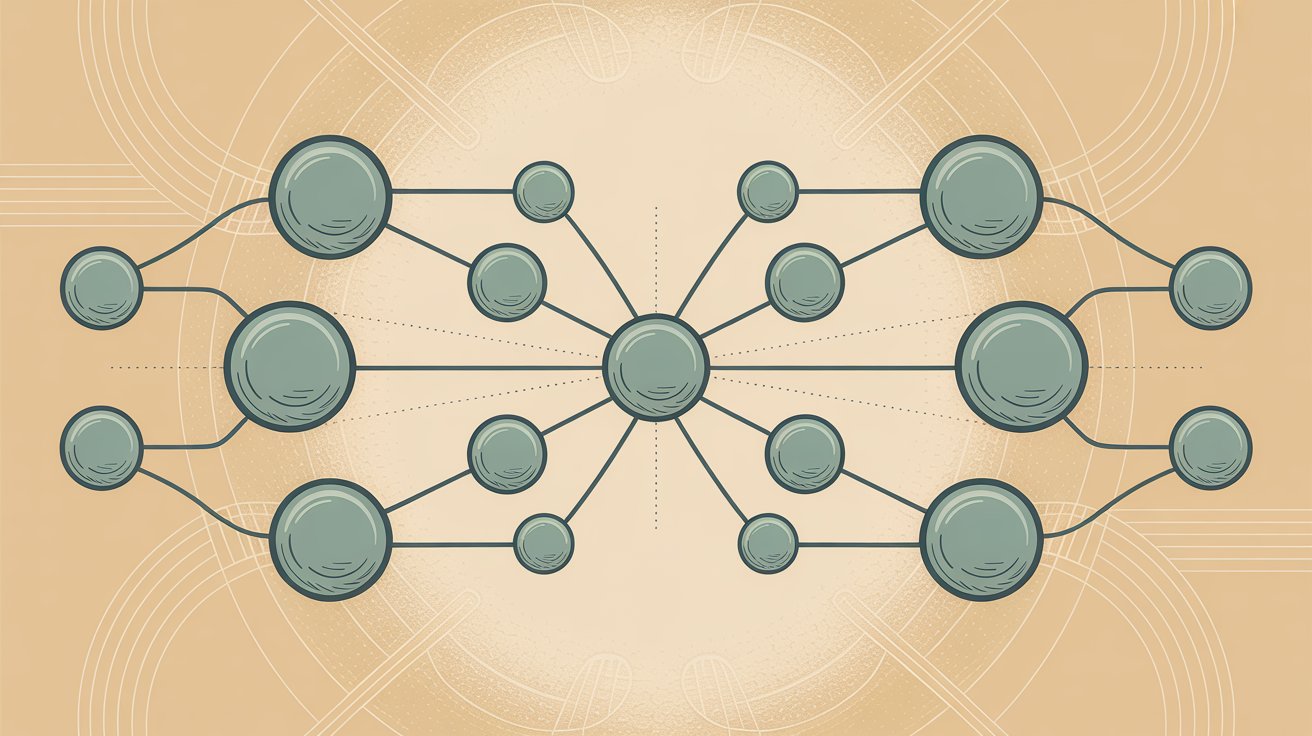
Finally, consider that no choice is forever. You might start with Type 1 and then graduate to Type 2 when ready. Or you might go for Type 2 and realize you need to maintain it annually. The key is to align the compliance effort with your business goals and client needs.
If done right, SOC 2 compliance (whether Type 1 or Type 2) becomes a business enabler, unlocking deals and proving your trustworthiness, rather than just a cost center.
Making the Final Decision: Type 1 vs Type 2 for Your Startup
Choosing between SOC 2 Type 1 and Type 2 comes down to what will best satisfy your current requirements while positioning you for future success.
If you need a quick win to get compliant and show good faith to customers, a Type 1 report is an excellent short-term solution that establishes your security baseline. It's faster, cheaper, and gets you in the game. However, a Type 1 is rarely the end of the journey.
Most organizations will need to obtain a SOC 2 Type 2 report eventually. It's the report that provides the highest level of assurance and is increasingly expected in B2B markets.
In an ideal world (with unlimited time and resources), you might go straight for the Type 2 to avoid duplicative work and demonstrate top-tier trust from day one. In the real world, practical constraints like deal timelines, budget, and youth of processes mean a phased approach can make sense. There's no one-size-fits-all answer.
Ask Yourself These Questions
What are my key stakeholders (customers, partners, investors) asking for, implicitly or explicitly?
If it's clear they won't accept anything less than a Type 2, that's a strong push in that direction.
How quickly do I need a SOC 2 report in hand?
If it's urgently fast, Type 1 is the way to achieve compliance in the short term.
Can I realistically demonstrate 3 to 12 months of consistent control operation right now?
If yes, you're a good candidate for Type 2. If not, do a Type 1 and use it to improve until you can.
Will doing two audits (Type 1 then Type 2) strain our team or budget unduly?
If so, maybe bite the bullet and invest in one Type 2 audit. If not, a preliminary Type 1 might actually save you from a costly failed Type 2 attempt.
What fits our growth stage?
Early startups often start with Type 1. More mature companies lean Type 2. Also consider what message each sends to your market about your maturity.
Remember: SOC 2 Is About Building Customer Trust
Remember the core purpose: SOC 2 is not just a compliance checkbox. It's about building customer trust. Both Type 1 and Type 2 can serve that goal in different ways.
In fact, many successful companies use Type 1 as a stepping stone: "We proved we have a solid foundation, and next we proved we run a tight ship continuously." By making an informed choice between the two (or deciding on the sequence of both), you ensure that your compliance efforts are efficient and aligned with your business needs.
Finally, don't forget to take advantage of tools and partners to make the journey easier. With the help of compliance automation (like Comp AI's platform) and expert guidance, getting audit-ready can be dramatically faster than the old manual ways, for both Type 1 and Type 2.
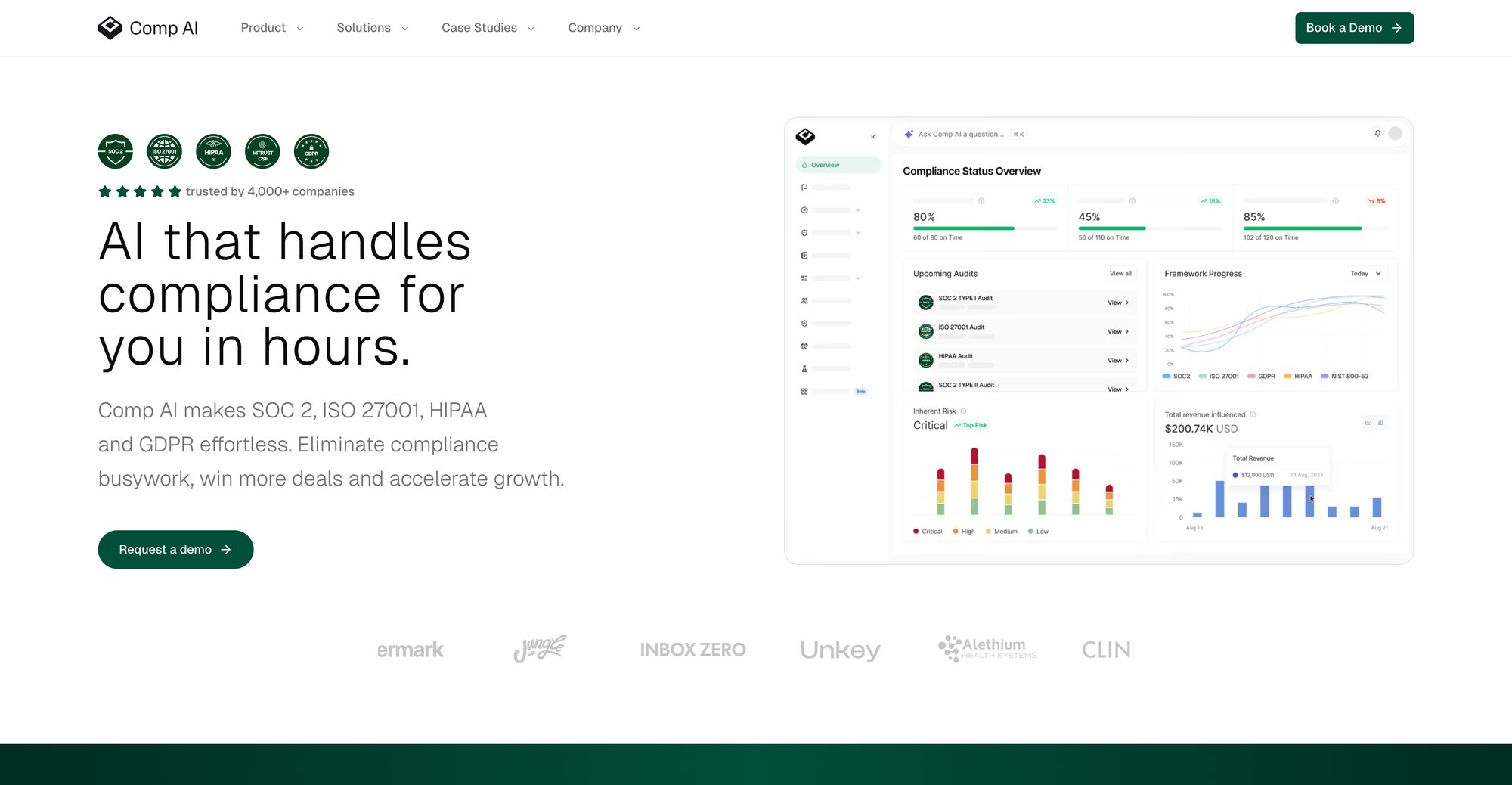
For instance, Comp AI's customers have become SOC 2 Type 1 audit-ready in hours and kickstarted Type 2 observation in days, thanks to 24/7 monitoring and done-for-you evidence collection. Speed and automation can help you whichever path you choose, so you can focus on your core business while still meeting that high bar of security trust.
In Summary
If you need immediate compliance proof with minimal time investment, start with SOC 2 Type 1.
If you need comprehensive assurance and your situation allows it, aim for SOC 2 Type 2.
Often, the answer is both (one after the other) to balance short-term needs and long-term trust.
By understanding the differences and evaluating your own context against the factors above, you'll make the right choice and set your organization on the optimal path to SOC 2 success. Ready to get started? Request a demo to see how Comp AI can accelerate your SOC 2 journey.
Frequently Asked Questions
Can I skip Type 1 and go straight to Type 2?
Yes, absolutely. Type 1 is not a prerequisite for Type 2. If you're confident in your controls and can demonstrate 3 to 6 months of operational effectiveness, you can pursue Type 2 directly. This approach can save time and money by avoiding duplicate audit efforts. However, many first-time organizations find Type 1 helpful as a learning experience before tackling the more rigorous Type 2.
How long does a SOC 2 Type 1 audit actually take?
Once your controls are in place and documented, a Type 1 audit can typically be completed in 2 to 4 weeks. However, the total time from deciding to pursue SOC 2 to receiving your Type 1 report usually takes 1 to 3 months for traditional approaches. With modern automation platforms like Comp AI, this timeline can be compressed to as little as 24 hours for audit readiness.
What happens after I get my Type 1 report?
A Type 1 report doesn't expire, but its value diminishes over time since it's a point-in-time assessment. Most companies use it for 6 to 12 months while they prepare for Type 2. During this period, you should continue operating your controls consistently to build the track record needed for a Type 2 audit. Many organizations schedule their Type 2 audit to begin shortly after completing Type 1.
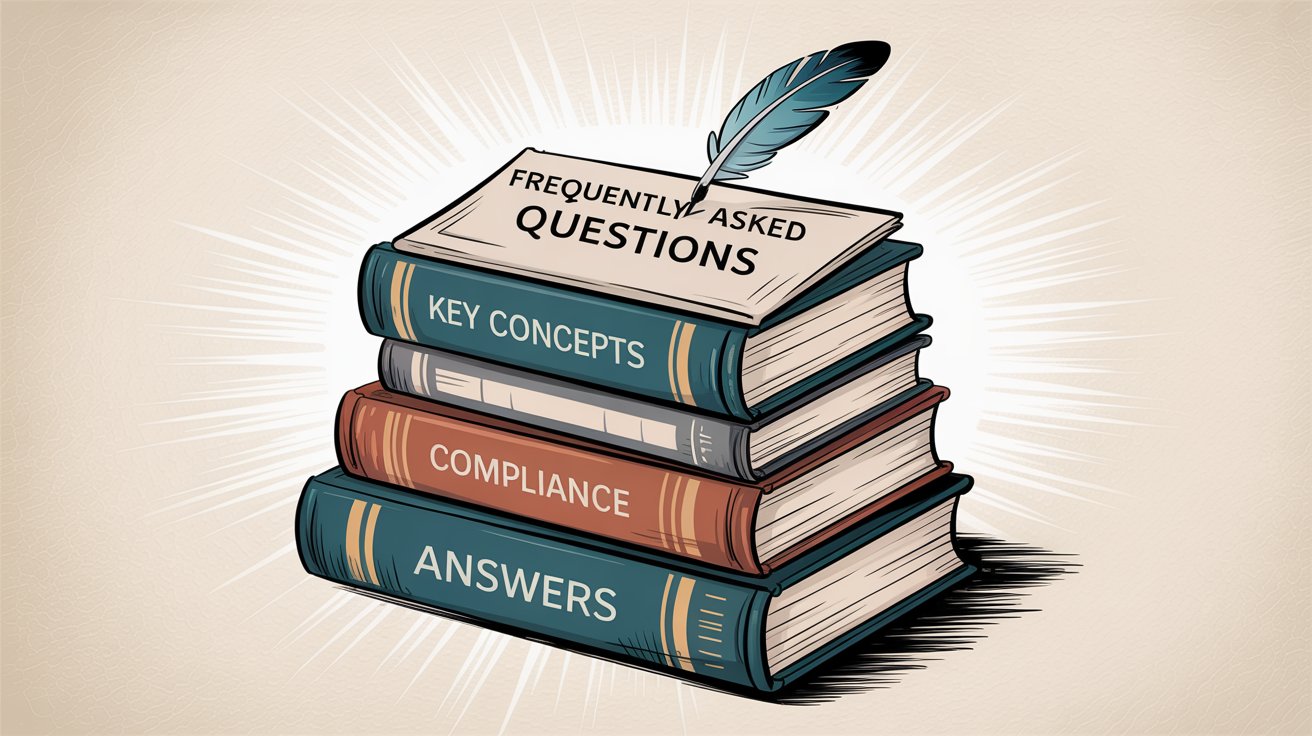
How much does a SOC 2 audit cost?
Type 1 audits typically cost between $5,000 and $25,000, depending on your organization's size and complexity. Type 2 audits are generally 30% to 50% more expensive due to the extended observation period and additional testing required. Keep in mind these are just auditor fees. You'll also need to factor in internal time, potential consulting support, or compliance automation platform costs. Use Comp AI's SOC 2 cost estimator for a personalized budget.
Can automation really get me audit-ready in 24 hours?
Modern compliance automation can dramatically accelerate the preparation phase. Platforms like Comp AI use AI agents to automatically collect evidence, draft policies, configure integrations, and monitor your infrastructure 24/7. While the actual audit still takes time, automation can compress months of manual preparation work into days or even hours. However, your specific timeline will depend on your starting security posture and how quickly you can set up any required controls.
Do enterprise customers really require Type 2, or will Type 1 work?
It depends on the customer, but increasingly, enterprise organizations prefer Type 2 reports. Security and procurement teams view Type 2 as more comprehensive proof of ongoing security practices. Some enterprises will accept a Type 1 as an interim step if you commit to completing Type 2 within a specific timeframe. The best approach is to ask your prospect directly what they require, rather than assuming.
How often do I need to renew my SOC 2 report?
Most organizations renew their SOC 2 reports annually. For Type 1, you would undergo a new point-in-time audit each year. For Type 2, you typically maintain continuous compliance and undergo an annual audit covering the past 12 months. Customers and prospects generally expect to see a report dated within the last year, so maintaining this annual cadence is important for ongoing business development.
What's the difference between SOC 2 and ISO 27001?
While both are security compliance frameworks, they differ in scope and approach. SOC 2 is primarily for service providers in North America and focuses on five Trust Services Criteria. ISO 27001 is an international standard with broader applicability and a more comprehensive set of controls. Many organizations pursue both to serve different customer bases. The good news is that with modern automation platforms, achieving multiple frameworks simultaneously is increasingly feasible. Check out Comp AI's guide on ISO 27001 certification requirements to learn more.
Will having a SOC 2 report actually help me close more deals?
Yes, especially in B2B SaaS and tech services. Many enterprise customers won't even consider vendors without SOC 2 compliance. A Type 2 report can be a significant competitive advantage, shortening sales cycles and reducing security questionnaire burden. It's common for companies to report that SOC 2 certification unlocked deals that were previously blocked by compliance requirements. However, the impact varies by industry and customer segment.
Share this article
Help others discover this content
More from Compliance Hub
Explore more insights and stay ahead of regulatory requirements.
OneLeet vs Delve: Which Compliance Platform Is Best? (2025)
Compare OneLeet and Delve compliance platforms: timelines, AI automation, pricing, and customer reviews. Plus see how Comp AI stacks up.
Thoropass vs Vanta: Complete Comparison (2025)
Compare Thoropass vs Vanta for SOC 2 compliance. Detailed breakdown of features, pricing, audit models, and which platform fits your startup best.
Vanta Pricing: Complete Cost Breakdown (2025)
Real Vanta pricing from customers: $15k-$30k+ total (platform + audit + fees). Compare costs, timelines, and see how to get compliant 10x faster.